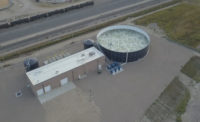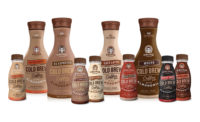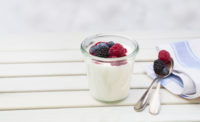Since expanding operations and moving from New Gloucester, Maine, 120 miles Northeast to Bangor, home of world-famous horror author Stephen King, Pineland Farms Dairy Co.’s growth and reputation has been anything but scary. In addition to producing 30 SKUs of award-winning, small-batch specialty cheese and processing milk onsite, the small dairy with a mighty team of just 30 employees has a quest to expand its brand beyond New England’s border.
“Right now, we’re processing roughly a million pounds of small batch, specialty cheese a year,” notes Larry Wintle, the dairy’s operations/production manager and second Master Cheesemaker. “On the cheese side, we’ve boosted our capacity 10-fold since our humble beginnings in 2004. Since we moved to our much larger plant [going from 12,000 square feet to 70,000 square feet] and manufactured our first cheese in our new facility in August 2018, we’ve been able to branch out on the fluid side.”
While Wintle knows there are many dairy plants running on a much larger scale than Pineland Farms, the quadrupled-sized plant has enabled the East Coast dairy — the largest cheesemaker in the state of Maine — to expand and grow its operations beyond cheesemaking to include bulk fluid milk, cream, ice cream mixes and dairy blends.

In 2013 the former Grant’s Dairy location, that had been acquired by Garelick Farms and then Suiza/Dean Foods, closed its doors permanently, leaving nearby family farms in a lurch because farmers would rather sell their milk to the closest dairies to ensure the freshest milk.
This challenge was solved a few years later, in February 2017, when Pineland Farms purchased the former dairy for $1 million, breathing new life into an old building and allowing milk from 20 family farms within a 50-mile radius of Bangor to freely flow again.
In 2021, Pineland Farms was 100% cheese as the fluid milk side was launching. “Today, the fluid side is equal to our cheese capacity,” relays Pineland Farms Dairy President Mark Whitney. “Our goal is to still grow and use more of Maine’s milk and support more of Maine farmers. We have a lot of capacity and could double our output on the cheese and fluid side of things, without adding any new equipment.”
For instance, processing 2 million pounds of cheese and 6 million gallons of milk is within the realm of possibility this year, but sales and distribution would need further growth to keep pace, Whitney and Wintle explain.
On the packaging side, the dairy expanded its capabilities to customize variety and sizing for its foodservice customers with 5-gallon bag-in-box (BIB), 300-gallon totes and tanker options, which have the ability to handle between 4,800 to 8,000 gallons, Wintle notes.
Due to celebrate its 20th anniversary in 2024, Pineland Farms doesn’t distribute its own products. Instead the dairy processor is reliant on foodservice distributors like Performance Foodservice, and Sysco, or retail customers and retail distributors picking up products from the 70,000-square-foot plant located at the aptly named 1 Milk Street.
“We specialize in dairy and cheese, so we let someone else specialize in trucking and logistics,” Wintle tells Dairy Foods during a plant tour. “We’re fortunate that we have a lot of customers who come and pick up, and luckily we’re right off Highway I-95, so it’s easy access.
“Cheese has a much longer shelf life than milk and dairy blends, so there isn’t an emergency to ship everything out on the same day,” he continues. “However, there’s more immediacy on the fluid milk side, which customers usually order by the trailer load.”
Whitney notes that the cheese side of the business requires 10 million pounds of milk annually, while 50 million pounds of milk are needed on the fluid side to produce dairy blends and ice cream mixes.
“That’s anywhere from four to 12 loads of milk a week, but if we want to build Pineland Farms to max capacity, processing 10 loads of milk a day, around 70,000 gallons, would be the goal,” Whitney says.
Yet, continually striving for quality, not quantity, remains a top mission for the dairy with the motto of “Connecting Community with the Land.”

A multi-generational commitment
“We’re proud to work with multi-generational farm families with a stellar herd lineage for the Holstein cows that produce our milk,” Whitney says. He points out that healthy calves weigh around 90 pounds at birth and at maturity, stand 58 inches tall at the shoulder and clock in at 1,500 pounds.
The statuesque black-and-white Holstein cows, the most prominent of the seven major dairy breeds, produce high-quality milk, a key ingredient to make great cheese, according to Whitney and Wintle.
The dairy’s award-winning specialty cheese is available in five lineups: Cheddars, Jacks, Swiss, Fetas and Curds.
Its most popular retail SKUs are Sharp Cheddar, Feta, Reserve 2-Year Aged Cheddar, Smoked Cheddar and Cheddar cheese curds. The most popular foodservice SKUs are Cheddar cheese curds, White Cheddar, Smoked Cheddar, Baby Swiss and Pepper Jack, says Jim Lesser, the dairy’s director of Marketing and Sales since 2021.
“While we have a state-of-the-art facility, we still use Old-World cheesemaking techniques,” Lesser states. “The hands-on cheesemaking ensures personal care goes into every batch. It shows in the quality and has been recognized by the awards our cheese has received. We are looking forward to expanding our distribution to new markets.”
Serving as production/operations manager at Pineland for nearly six years, Wintle began his career in the dairy world in 1981 at H.P. Hood in Newport, Maine, and spent 23 years as Master Cheesemaker for Cabot Co-op in Vermont. The well-rounded dairyman also has hands-on experience working with other dairy products, including ice cream, fluid milk and cultured products.
At Pineland Farms, fluid milk production is fully automated with human machine intelligence, while the cheese side is strictly manual, he notes.

Quality craftsmanship during milk processing
Out of two milk truck receiving bays, milk processing steps are similar to the cheesemaking side as far as testing the milk, Wintle says. (See Inside the Plant sidebar).
First, the team looks at its orders and figures out how much skim and whole milk is needed.
He explains the quality control used: “We'll either batch or inline standardize the butterfat through the separator into one of our milk standardized tanks to make the load that was ordered. Then we’ll pasteurize it with automated routing valves into the pasteurizer, into the finished pasteurized tanks, and from that point we have other staff dispense the finished product into 300- gallon totes, which weigh 2,500 to 2,600 pounds.
“We also have our blends, where we’ll standardize our milk fat again through the separator room and then we’ll route it again, to our batch tanks where we do particular blend recipes, where we’ll add oils, powders and sugars, depending on the blend we’re making,” he continues. “Once the blend is done, we analyze it through the lab, and once it’s cleared, we’ll start up our pasteurizer equipment and pasteurize the blend into our finished pasteurizing tanks.
“We’ll either start up our BIB filler, which processes two-and-a-half gallon or five-gallon bags into a box, or we’ll use our 300-gallon totes,” he adds. “If we have a market for it, we can do tanker loads, which range from 4,800 to 8,000 gallons.”
Production aside, Wintle and Whitney suggest that the state they’re working in gives them ample opportunity to “expand the brand” beyond the New England borders into New York, New Jersey, Pennsylvania, and other Northeastern states.
“I think on the fluid side, there will be opportunities for us where economy of scale exists,” Wintle suggests. “The market up here isn’t that drastically different from other dairy markets. We’re all dealing with expensive prices to ship.
While Pineland Farms’ products are well-known in parts of New England, Whitney knows there’s distribution gaps to fill in order to move its dairy products outside of New England.
“I think of Maine as an agricultural state and how that all ties together. There’s forestry, there’s farming and it even takes into consideration the seacoast,” he concludes. “That’s what I want our cheese and fluid products to be recognized for — the care, quality and pride we have in producing them.”
SIDEBAR
A typical day at Pineland Farms Dairy
- Pineland Farms receives one to two trailer loads of milk into its raw receiving station in two truck bays. Operators put on safety clothes, go to the top of the tankers and open up one or two of the non-pressure, steel manways to get a sample. They’ll sample the milk into a few vials and check the temperature to make sure it’s 45 degrees Fahrenheit or less. Milk samples go into the quality assurance lab, where they undergo two tests: an antibiotic check and a Direct Microscopic Count for bacteria (DMC) to ensure the raw bacteria meets standards.
- Operators go back to receiving stations and hook the truck to a 3-inch sanitary hose where it is routed to a specific silo depending on where the milk is going to be used. Pineland has five stainless steel silos that combined hold up to 90,000 gallons of milk at any one time.
- Further in the milk’s journey are employees who are cross-trained as high temperature short time (HTST) pasteurizers. They are responsible for the legal pasteurization of milk or dairy products using HTST pasteurization equipment. If cheese is the product, the raw milk goes into the milk pasteurizer, where it is pasteurized to a minimum 161 degrees for 15 seconds and then cooled down in stainless steel plate/frame to 90 degrees Fahrenheit. As the vat, which holds 16,000 pounds, is filled, the cheesemakers adds live starter culture before it is automatically shifted to another vat, where the filled vat is then injected with rennet to foster coagulation of the product. Typically, it takes 30 to 45 minutes for the vat to get the correct coagulation.
- The next step uses open wire knives to cut the coagulum into curds and whey followed by agitation within the open vessel to keep them suspended. Next, the curds and whey are cooked to 101 degrees. After the desired temperature is reached, a valve at the end of the vat facilitates the transfer of curds and whey to an open, shallow finishing table where the whey is drained off, leaving the curd behind.
Wintle notes Pineland Farms Dairy has two ways of making cheddar cheese, the traditional way (milled cheddar) where the whey is drained off from a trench in the center of the vat and the cheese goes to the walls of the vat, where it is cut into loaves. The loaves are continually flipped as the pH is monitored until it goes down to 5.3. The loaves are milled into cheddar curds where they are salted and hooped into 40-pound blocks and then pressed.
In a more conventional way (stirred cheddar) of cheesemaking, the whey is drained off the table with stirrers intact in the table. The big difference is the vat is not trenched, Wintle explains, and then the aforementioned steps are followed, with the ability to add different ingredients and time in the case of aged cheddars, which are aged up to four years.
“Typically, we do two to four vats a day,” Wintle concludes, noting that a single vat yields 1,600 pounds. “We’re processing anywhere from 3,200 to 6,400 pounds of cheese a day.”







